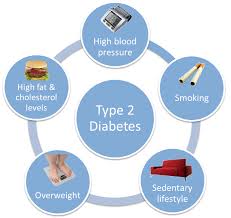Diabetes 2 is serious metabolic disorder faced by huge population of the world. It is the most common type of diabetes in adults. The increase in number of individuals with diabetes is increasing in alarming rates. With increased obesity cases diabetes 2 is also increasing. Obese people and people in whose family diabetes prevails are at higher risk of having this type of diabetes. It is characterized by hyperglycemia (high blood sugar) due to resistance to insulin or lack of insulin. Type 2 diabetes makes up to 90% to the total diabetes cases. It can be managed at early stages by proper exercises and food intake. If this continues medication is required to monitor the sugar level. If it is not controlled many complications occur eventually. Read about Diabetes mellitus type 2.
Table of Contents
Cause
The development of type 2 diabetes is caused by a combination of lifestyle and genetic factors. While some of these factors are under personal control, such as diet and obesity, other factors are not, such as increasing age, female gender, and genetics.
A lack of sleep has been linked to type 2 diabetes. This is believed to act through its effect on metabolism. The nutritional status of a mother during fetal development may also play a role, with one proposed mechanism being that of altered DNA methylation.
Signs and symptoms
- Polyuria (frequent urination)
- Polydipsia (increased thirst)
- Polyphagia (increased hunger)

- Weight loss
- Blurred vision
- Itchiness
- Peripheral neuropathy
- Recurrent vaginal and urinary tract infections
- Fatigue
- Hyperosmolar hyperglycemic state
- Decreased level of consciousness
- Low blood pressure
Complications
Type 2 diabetes is typically a chronic disease associated with a ten-year-shorter life expectancy. This is partly due to a number of complications with which it is associated, including: two to four times the risk of cardiovascular disease, including ischemic heart disease and stroke, a 20-fold increase in lower limb amputations. In the developed world, and increasingly elsewhere, type 2 diabetes is the largest cause of non traumatic blindness and kidney failure. It has also been associated with an increased risk of cognitive dysfunction and dementia through disease processes such as Alzheimer’s disease and vascular dementia. Other complications include sexual dysfunction, and frequent infections.
Prevention and treatment
Onset of type 2 diabetes can be delayed or prevented through proper nutrition and regular exercise. Intensive lifestyle measures may reduce the risk by over half. The benefit of exercise occurs regardless of the person’s initial weight or subsequent weight loss. Evidence for the benefit of dietary changes alone, however, is limited, with some evidence for a diet high in green leafy vegetables and some for limiting the intake of sugary drinks. In those with impaired glucose tolerance, diet and exercise either alone or in combination with metformin or acarbose may decrease the risk of developing diabetes. Lifestyle interventions are more effective than metformin. While low vitamin D levels are associated with an increased risk of diabetes, correcting the levels by supplementing vitamin D3 does not improve that risk.

